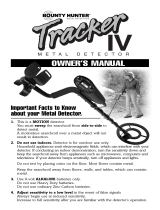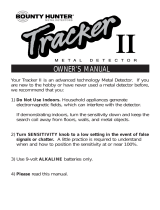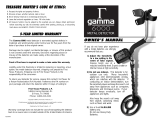Page is loading ...

OWNER’S MANUAL
The Basics
of Metal Detecting
Your Fast Tracker Metal Detector is a MOTION metal detector; movement over
an object is required in order for the machine to detect an object and emit a tone.
The Fast Tracker has eliminated the two most difficult aspects of detecting -
ground balancing and target tuning. Both of these functions are automatic. With
only two operating knobs, you are on the Fast Track to finding buried treasure!
CAUTION:
FOR OUTDOOR USE ONLY:
• If demonstrating indoors, beware of interference from electromagnetic
fields.
• If interference occurs, the detector will chatter or beep erratically.
• To avoid interference, turn the sensitivity down, turn off lights and
appliances, or use outdoors.
DO NOT TEST ON THE FLOOR
Most floors contain metal, which will interfere with the target’s signal.
USE 9 volt ALKALINE batteries ONLY.

2
FAST TRACKER FEATURES
Fast Tracker FEATURES
Interchangeable
Coil System
Headphone Jack
S-Rod
Handle System
Detector
Stand
7" Waterproof Coil
Comfort
Hand-grip
Padded
Armrest
Discriminate
Control
Sensitivity Control

3
EASY ASSEMBLY
Search Coil
Search
Coil
Cable
Upper
Stem
Control
Housing
Plug
Lower
Stem
Assembling your Fast Tracker Metal
Detector is easy and requires no
tools. Just follow these steps:
●
1 Using the supplied bolt and
knurled knob, attach the
search coil to the lower stem.
●
2
Press the button on the upper end
of the lower stem and slide the
lower stem into the upper stem.
Adjust the stem to a length
that lets you maintain a com-
fortable upright posture, with
your arm relaxed at your
side. Maintain the search coil
about 1 inch above the
ground as you sweep.
●
3 Wind the search coil cable
around the stem. Leave
enough slack in the cable to let
you adjust the coil when you
are hunting on uneven
ground. Then tighten the knob
at the end of the search coil.
Note:
To adjust the coil,
simply loosen the knob.
●
4 Insert the coil’s plug into the
matching connector on the
control housing. Be sure the
holes and pins line up correctly.
Caution:
• Do not force the plug in.
Excess force will cause damage.
• To disconnect the cable, pull
out the plug. Do not pull on
the cable.
Bottom side
Lower
Stem
Upper
Stem

4
BATTERIES
Use ALKALINE batteries only.
Follow these steps to install the batteries.
●
1 Carefully remove the battery compartment door by pressing
the release clip on the right side of the door.
●
2 Snap one battery on to each of the terminals and place the
batteries inside the compartment.
The battery compartment is a tight fit. Insert one battery
with the terminals facing down, and the second battery with
the terminals facing outward. See illustration.
●
3
Replace the compartment door by first inserting the hinge on
the side opposite of the release clip.
●
4
Then, press down firmly on the clip side until the battery door
snaps into place.
First Battery
Second Battery
First Battery
terminals facing in
Second Battery
terminals
facing out
Release
Clip

5
Here is a quick way to demonstrate the basic features of your FAST TRACKER.
Supplies Needed
a. A small nail d. A nickel
b. A small piece of foil e. A dime
c. A quarter f. A penny
Position your Fast Tracker
Keep the detector away from metal objects.
Have a friend hold the detector while you pass the objects over the search coil.
Or, hang the detector over the edge of a chair or table, away from walls,
floors and other metal objects.
Remove your jewelry and watch (they also contain metal)
Demonstrate It!
a.
Click the power on, and turn the Sensitivity Knob to
the 2:00 or 3:00 position.
b. Click the right knob (Discriminate) off. 100%
to the left.
c. Sweep all of the objects back and forth over the
search coil.
NOTICE the SINGLE TONE
d. Sweep the nail back and forth over the search coil.
While sweeping, click the Discriminate Control
(right knob) on.
Turn the Discriminate Control until the nail is no
longer detected.
You have “discriminated out” the nail.
e.
Now pass the nickel with the Discriminate control in
the 1:00 or 2:00 position.
NOTICE the LOW TONE.
f. Pass the Quarter.
NOTICE the HIGH TONE.
g. Pass all of the objects, while moving the
Discriminate Control to
differing positions.
NOTICE the DIFFERENT TONES, or
NO TONE at all.
FAST DEMONSTRATION

6
OPERATION
The Fast Tracker is a MOTION metal detector; the search coil must be in
motion over the targeted object in order for the machine to detect the
object and emit a tone. Motion is required in order for the detector to
automatically GROUND BALANCE. All soil and sand is different,
containing varying amounts of naturally occurring minerals. As you
sweep the search coil over the ground, your metal detector is constantly
READING and AVERAGING the ground’s mineralization, in order to
differentiate between the naturally occurring ground minerals and a metal
target.
Adjust the SENSITIVITY
After powering the unit on, turn the left
knob, SENSITIVITY, 100% clockwise. If
the detector chatters or emits erratic
sounds, reduce the sensitivity by turning
the knob to the left. The detector will
work well at the 2:00 or 3:00 position.
This adjustment is necessary due to
electromagnetic interference.
Household appliances, lighting fixtures,
outdoor power lines (overhead and buried) all emit electromagnetic fields.
Electromagnetic energy also occurs naturally in the environment. Your
metal detector creates its own magnetic field; so you need to adjust your
SENSITIVITY to compensate for any interference.

OPERATION
Select the MODE OF OPERATION
The Fast Tracker has two operating modes, ALL METAL and DISCRIMINATION.
ALL METAL
To enter the ALL METAL mode, click the right knob (Discriminate) off, 100%
counterclockwise. In the full counterclockwise position, you will detect all
types of metal.
In the ALL METAL mode, your detector will emit only one tone, regardless of the
type of metal detected. It will detect low-grade metals like iron (a nail) or
aluminum (foil). It will also detect more valuable items like silver, copper, and gold.
APPLICATIONS:
Use the ALL METAL mode for household applications, such as finding
property markers or lost objects like keys or machine parts.
ALL METAL is also useful for gold prospecting. Be aware that you need to
search in an area where gold has been found in the past.
ALL METAL is also preferred for relic hunting. Many relics are made of iron.
You must be in the ALL METAL mode to detect iron.
Maximum depth detection is achieved in the ALL METAL mode.
DISCRIMINATION
Click the Discriminate Control (right Knob) on to enter the DISCRIMINATION mode.
Discrimination is the elimination of certain metals from detection, and the
classification of targeted metals using audio feedback. See chart below.
As the chart illustrates, iron and steel will be discriminated out, inducing no
audio response. Nickels and gold items will induce a low tone. Silver,
copper, and brass will induce a high tone. Many pull-tabs (but not all) will
induce a “broken” tone. To achieve the broken tone, set the discriminate
control at the approximate center position, about 12:00.
Depth of detection is slightly reduced in the DISCRIMINATION mode.
TONE MODE AUDIO RESPONSES
NO
RESPONSE
Iron & Steel
LOW
TONE
Gold & Nickel
BROKEN
TONE
Old & New Pull Tabs
HIGH
TONE
Copper, Silver &
7

8
IN THE FIELD TECHNIQUES
SWEEP TECHNIQUE
Sweep the search coil in a slow, consistent, side-to-side motion. The detector’s
circuitry is constantly calculating the ground’s mineralization. A steady,
consistent coil speed is required for the detector to make an accurate calculation.
Keep the search coil about one inch above the ground. Keep the coil even with
the ground. Do not raise the coil at the ends of your sweep.
TONE RESPONSE
Only dig up targets that induce repeatable tones. Each time you pass the search
coil over a possible target, you should hear the same tone. If the tone does not
repeat on each pass, varies in tone, or varies in location, then the target is
usually not of value.
Inconsistent tones are evidence of high oxidation (rusted metal) or irregularly
shaped trash items.
Note, however, that multiple tones may be evidence of multiple targets.
If you cannot pinpoint the location of a very strong signal, lift the coil higher off
of the ground until a weaker, but more precise signal is heard.
For very weak signals, try moving the coil in short, rapid sweeps, closer to the
ground.
CORRECT
WRONG
WHAT
READS
LIKE THIS
…MAY
ACTUALLY
BE THIS

9
TROUBLESHOOTING
The following troubleshooting steps may assist you in case you’re having prob-
lems with your Detector.
YOUR DETECTOR IS EMITTING ERRATIC SIGNALS WHEN YOU’RE IN THE FIELD.
Your SENSITIVITY may be set too high. Try reducing the SENSITIVITY slightly until
the false signals stop.
Remember to swing your coil slowly. Some inconsistent signals will occur on highly
rusted metals. If the signal does not repeat after successive passes of the coil over the
same area, then the target is usually not worthwhile.
Natural and man-made electromagnetic fields can cause interference.
YOUR DETECTOR IS NOT STABLE AND HAS A PULSING, DISTORTED TONE
INSTEAD OF A CLEAR TONE.
This can occur if you’re operating near another detector or near power lines that can
interfere with the detector’s operating frequency.
YOUR DETECTOR IS EMITTING A CONSTANT LOUD TONE OR
CONSTANT REPEATING TONES
This usually occurs when the batteries are low. Try replacing your batteries with
two new alkaline batteries.
KEEP 2 DETECTORS AT LEAST 20ft APART
If 2 detectors are in close proximity, interference between the two may cause your
detector to emit erratic signals.
PINPOINTING
Accurate pinpointing takes practice and is best accomplished by “X-ing” the sus-
pected target area.
●
1 Once a buried target is identified by a good
tone response, continue sweeping the coil over
the target in a narrowing side-to-side pattern.
●
2 Take visual note of the place on the ground
where the “beep” occurs as you move the coil
slowly from side to side.
●
3 Stop the coil directly over this spot on the
ground.
●
4 Now move the coil straight forward and
straight back towards you a couple of times.
●
5 Again make visual note of the spot on the ground at which the “beep” occurs.
●
6 If needed, “X” the target at different angles to “zero in” on the exact spot on
the ground at which the “beep” occurs.
IN THE FIELD TECHNIQUES

10
CARE AND MAINTENANCE
Your Fast Tracker Metal Detector is an example of superior design and
craftsmanship. The following suggestions will help you care for your
metal detector so that you can enjoy it for years.
Handle the metal detector gently
and carefully. Dropping it can
damage electronic components.
Use and store the metal detector
only in normal temperature
environments. Temperature
extremes can shorten the life of
electronic devices and distort or
melt plastic parts.
Wipe the metal detector with a
damp cloth occasionally to keep
it looking new. Do not use harsh
chemicals, cleaning solvents, or
strong detergents to clean the
metal detector.
The coil is waterproof and may
be submerged into either fresh or
salt water. Be careful to prevent
water from entering the control
housing. After using the coil in
salt water, rinse it with fresh
water to prevent corrosion of the
metal parts.

11
METAL DETECTING APPLICATIONS
COIN SHOOTING
Searching for coins is the most popular metal detecting application. We receive testimonials
every day from BOUNTY HUNTER users finding very old coins — many times from the
1800’s or earlier — in old school yards, parks, and even their own back yards.
To adjust your detector for coin shooting, you want to click on the ALL METAL control
knob to about the 1:00 position. Find an older pull tab, and adjust the discrimination
control to the point where you hear a broken, in-between, sound. At this setting,
you have eliminated all iron objects, and will be aware of the presence of pull tabs,
as they usually induce this broken tone.
Long-buried coins can often be detected deeper than newer coins. As an old coin
oxidizes, it creates a magnetic halo in the soil, effectively increasing the size of its
magnetic signature, and its detectability.
JEWELRY HUNTING
Keep the discrimination control at the 11:00 setting for jewelry hunting. Many gold
rings will register similar to pull-tabs. Beware that you will dig up many pull tabs in
the search for gold rings. Both pull-tabs and gold rings can induce a low tone. Keep
the discrimination control at the lower, 11:00, setting so that you do not eliminate
small gold rings from detection.
Some gold rings can induce a double beep whereas most pull-tabs will not. To
achieve the double beep, move the coil very slowly over the buried target at differing
angles. You can sometimes achieve a double beep as the search coil passes over
two sides of the ring.
Necklaces can be very difficult to detect. Silver rings will induce a high tone. Highly
oxidized trash items can also induce high tones.
RELIC HUNTING
A relic is a historical object, sometimes of great value. Relics are often made of iron or
bronze. Therefore, keep your discrimination control turned off, in the 100%
counterclockwise position. In this ALL METAL mode, you will detect all types of metal,
including trash items. You must limit you relic-hunting activity to areas where you have
a reasonable suspicion of finding an ancient object. Visit the local library to learn of
historical events which occurred in the area. Remember to always obtain permission
before searching property which is not your own.
CACHE HUNTING
A cache, pronounced “cash”, is a hidden store of valuables. Years ago, many people
stashed valuables in cans, bags, and metal chests. They often buried them or hid them
in the walls or floors of their homes. Search old homes or camp sites to locate caches.
Caches are very rare and hard to find. Cache hunting requires the ALL METAL mode;
so keep the discrimination control turned off.
HOUSEHOLD APPLICATIONS
Lost keys or machine parts, underground pipes, and property markers can all be located
using the ALL METAL mode. Keep the discrimination control in the off position.

TREASURE HUNTER’S CODE OF ETHICS:
1. Respect the rights and property of others.
2. Observe all laws, whether national, state or local.
3. Never destroy historical or archaeological treasures.
4. Leave the land and vegetation as it was. Fill in the holes.
5. All treasure hunters may be judged by the example you set.
Always obtain permission before searching any site. Be
extremely careful while probing, picking up, or discarding trash
items. And ALWAYS COVER YOUR HOLES!
First Texas Products, LP
1100 Pendale Road
El Paso, TX 79907
(915) 633-8354
REVISED 10/04
Bounty Hunter Metal Detectors are warranted against
defects in workmanship or materials under normal
use for five years from date of purchase to the
original user. Liability in all events is limited to the
purchase price paid. Liability under this Warranty is
limited to replacing or repairing, at our option, any
Bounty Hunter Detector returned, shipping cost
prepaid, to First Texas Products, LP. Damage due to
neglect, accidental damage or misuse of this product
is not covered by this warranty.
FIRST TEXAS PRODUCTS, LP
5-YEAR LIMITED WARRANTY
Copyright© 2004 by First Texas Products, L.P.
All rights reserved, including the right to reproduce this book, or parts thereof, in any form.
Published by First Texas Products, L.P.
Bounty Hunter
®
is a registered trademark of First Texas Products, L.P.
www.detecting.com
/












